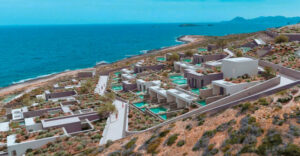One of the most complex problems the government must urgently address is urban and spatial planning, involving regulations primarily linked to the New Building Code (NOK), off-plan development, and tourism. All this while the market is in chaos, as legislative inaction has brought construction permits to a halt, with the timing of government initiatives still uncertain. The construction sector is in total disarray.
On one hand, fortunes are at risk due to the lack of a legal framework (NOK), while on the other, new ones are being made for the privileged—investors and private individuals—who managed to enter the strategic investment regime and secure customized, exception-based building terms tailored to their needs.
Even those who bought land and obtained permits under existing law are now in despair, as Council of State rulings are nullifying NOK provisions, extending legal uncertainty as new regulations from the Ministry of Environment and Energy (YPEN) are still pending.
The government, having been in power for almost six years, should have not only legislated and imposed order on this unregulated field, but also ensured its interventions were legally sound, avoiding being struck down as unconstitutional by the Council of State.

SANTORINI – OIA
Backed into a corner, the new Minister of Environment and Energy, Stavros Papastavrou, must urgently show results and provide solutions to the complex urban and spatial issues that have driven citizens to despair due to the state’s inaction and its dysfunctional services.
The deeply entrenched Hydra of planning, the rampant illegality in island areas, and the freezing of construction approvals make for a rough road ahead—with society itself acting as the strictest watchdog. The puzzle is completed by the still-pending regulations on off-plan construction, the legal registration and codification of recognized roads, and the complete lack of spatial planning in areas such as green energy, tourism, industry, mineral wealth, and maritime zoning—fields riddled with legislative voids that now burden the new leadership.
During the handover ceremony, the outgoing Minister, Theodoros Skylakakis, vividly warned Mr. Papastavrou of the labyrinthine nature of the ministry, using the allegory of Sinis the Pine-Bender—who would tie his victims to two bent pine trees and let them snap back to dismember the body. “This ministry has two pines,” he said, “one is energy and the need for growth, the other is environmental protection. The forces pulling each way are deeply rooted, and the minister must balance both and follow the middle path.”
The Torment of Permits
One of the most immediate urban planning challenges passed like a hot potato to the new YPEN leadership—with the help of seasoned deputy minister Nikos Tagaras—is how we’ll be building from now on.
In construction, time effectively froze in December 2024, when the Council of State, as expected, overturned the bonuses of the 2012 Building Code. These bonuses promoted designs ensuring energy efficiency and common-use spaces in densely built urban areas. The court ruled that such provisions cannot apply broadly without prior environmental assessment.
The Ministry now must deal with permits already issued under these now-invalidated NOK provisions, where construction has not yet begun, ensuring continuity for those who lawfully obtained permits and even began work at various stages.

The implementation of the NOK has already created precedents in certain areas, with increased building heights. Several municipalities have frozen the issuance of new permits (some decisions now being reversed), awaiting final guidelines from YPEN. Though the Ministry claims to be in the final stage of drafting new rules, which the new leadership must now assess, no “remedy” for the NOK annulments has yet been presented, lengthening the list of lawsuits from contractors seeking compensation from both municipalities and YPEN.
The entire construction market is awaiting a new framework to chart a path forward, particularly regarding:
a) Permits not yet issued or initiated—these are the Ministry’s biggest headache, as they may lead to claims due to pre-signed contracts;
b) Cases where work was suspended due to lawsuits and is still in early stages;
c) Projects where construction has begun but not reached the point the Council of State considers a commencement of works;
d) Sites halted by appeals, yet already well underway or even completed.
Recently, the Municipality of Alimos reversed its own December 18, 2024 order freezing works. Out of 40 stalled permits, 10 have been cleared to proceed, with others under review. In one case, legal action and a compensation claim have been filed, with more expected shortly.
The Regulations
YPEN intends to push its new regulations through a Presidential Decree, allowing them to undergo Council of State review—though this will further delay the formal adoption of the legal framework, with clarity expected no sooner than early summer.
The Ministry promises to fast-track permit revisions and minimize financial loss for affected parties. One proposal, under former minister Skylakakis, would allow reimbursement of taxes paid on extra building square meters (now invalid due to the court ruling). Another idea is environmental compensation: in overbuilt areas, adding green spaces or integrating public zones could offset building intensity. The previous leadership had already institutionalized the concept of environmental equivalence—for example, allowing a factory or other environmentally burdensome project if it also yields ecological benefits (like more greenery or wildlife restoration).
Out-of-Plan Development
The “mess” the government has spread now extends to out-of-plan development, which, through successive decisions of the Council of State, now requires frontage on a recognized or public road. The Supreme Administrative Court has made it clear that having a plot of four stremmas is not enough to build; a recognized road is also needed to make a plot eligible for construction. An additional issue it raised is who will build that road, since the logic of “whoever builds, opens their own road” can no longer continue!
Roads are a parallel process in urban planning and are part of an approved road network that serves to connect settlements, activities, or facilities. The first phase involves recording the road network throughout the country and then categorizing it. That is, determining which roads are recognized (by public authorities, municipalities, or regions) and which are not. “This stage is very critical, because if some roads are not recognized, a large portion of out-of-plan plots may become unbuildable,” says architect-urban planner and director of the Urban Planning Research Lab at the NTUA School of Architecture, Kostas Serraos, speaking to “THEMA”.
He describes the regulation on out-of-plan areas as a major headache. “We’ve been building in out-of-plan zones since 1923, outside organized city plans or defined settlements. In my view, this needs to be regulated somehow, and we need to redirect construction towards city plans or organized zones (tourism, industry, etc.) so that building isn’t scattered all over out-of-plan areas. How we transition from one system—where we could get a permit—to another where that’s restricted or eliminated is a real puzzle.”
As he notes, it’s difficult for a policymaker to handle this because it triggers side effects. Today, the prevailing perception is that anyone with four stremmas can build 200 square meters. “This has affected land values, which are higher than a pasture that can’t be developed. Based on that premise, both locals and foreign investors have poured money into buying out-of-plan plots that were buildable at the time. So how can someone now come along and overturn all that? That’s the issue,” Serraos says.
To this day, the government has avoided legislating on out-of-plan development, even though its plans came very close. But weighed against public backlash and criticism, these regulations remain pending at a time when pressure—especially in island destinations due to intense tourism growth—remains high.

Where building is banned
Until the urban planning process commissioned by the Ministry of Environment and Energy (YPEN) and carried out by the Technical Chamber of Greece is completed, the ministry has chosen, as an interim solution, to suspend the issuance of building permits in many islands. However, even this policy has failed to absorb the shocks of tourism pressure and cannot be adopted indefinitely.
Mykonos, Santorini, and recently Milos are under such bans in parts of the islands, with some areas (e.g., Santorini) expected to see expanded restrictions. Meanwhile, requests for construction limits have also been submitted by Sifnos and Kos, islands facing a construction frenzy for tourism development.

Recently, a group of Sifnos residents filed a petition with the Council of State, obtaining a temporary injunction to halt construction on two underground tourist complexes with pools, aiming to protect the island from the cement invasion. Engineers and municipal representatives visited the Ministry of Environment to request intervention to stop construction on every corner of the island. The residents denounce the state’s inaction in protecting the islands and are trying to take matters into their own hands.
Kos was the latest municipality to join, submitting a request to YPEN to suspend new hotel construction permits—supported by a petition signed by 1,600 citizens. With a population of about 37,000, Kos welcomes approximately 1.5 million tourists annually, making it one of the most heavily burdened tourism islands. Although tourism is the island’s major industry, locals argue its carrying capacity has been exceeded. Hotel beds increased by 43%, from 40,240 in 2009 to 57,463 in 2023, with five-star rooms up 352%.
According to a recent technical report by Europa Nostra and the European Investment Bank Institute—part of a program aimed at protecting Cycladic identity—the islands are increasingly losing control to non-residents, and land is passing into the hands of organized hotelier and developer interests. For example, real estate companies in Ios with joint ownership now control 30% of the island’s properties, gaining significant influence. In the past five years, two five-star hotels have been built, and there are plans for nine more large-scale developments, including integrated tourist resorts and marinas—three of which are designated as strategic investments.
The report, which is part of the “7 Most Endangered” heritage sites program in Europe for 2024, examines the cases of three islands—Sifnos, Serifos, and Folegandros—proposed last year for inclusion by the Hellenic Society for the Environment and Cultural Heritage (ELLET) in order to prevent excessive tourism development across the Cyclades.
The report, drafted after field visits and research by experts, highlights, according to ELLET Institutional Framework Council Chair Betty Chatzinikolaou, the severe pressure islands are under from overdevelopment of tourist housing. This has led to the degradation of the natural landscape, overburdening of infrastructure, serious water shortages, and mass tourism pushing locals out due to the soaring cost of living.
An extra 500,000 sq.m. in Santorini
The report cites claims from the mayor of Santorini, stating that in recent years an additional 500,000 square meters have been added to the island—excluding buildings constructed without permits! Even though there’s a ban on new permits, construction reportedly continues under existing licenses and strategic investments that are altering the island’s natural landscape. Similar pressures are being felt on smaller Cycladic islands.
In Serifos, where 60% of the island falls under the Natura 2000 network, the permanent population is just 1,250, while summer numbers swell to 9,000—a 7.3-fold increase. From 2018 to 2023, 78 building permits were issued, adding 14,711 square meters. Meanwhile, in Folegandros, which faces severe water shortages like many other islands nationwide, a major strategic tourism investment has begun: 25 suites, each with its own pool, and plans for additional suites, 10 villas, and hydrotherapy centers.
Out-of-plan development is a top priority for the new government, alongside the New Building Code (NOK) and reforming unauthorized construction, as stated recently by the new Minister of Environment and Energy. The government is focusing on local and special urban plans being drafted for 100% of the country, with a completion target of 2026. However, it seems to overlook the fact that the tight timeline will require public consultation—during an election period (local consultations will peak next year)—and that the Council of State’s review of over 200 Presidential Decrees will be an uphill battle with completely unpredictable timing, based on the court’s usual pace.
This factor must be taken into account by the new political leadership, as there will be at least a two-year period (at best) during which the state must offer solutions to various pressures (residential, tourism, etc.) across the country for development—at a time when a comprehensive urban plan will not be in place for most of the territory.
High-voltage energy
But it’s not just environmental issues heating up the temperature at this multifaceted ministry. The energy sector is the second “leg” of the Ministry of Environment and Energy (YPEN), in a tense geopolitical period requiring both diplomatic skill and strong international networks—a field where Deputy Minister Nikos Tsafos is also expected to play a key role. From day one at YPEN, he set the bar high, stating that the Crete–Cyprus–Israel power interconnection—which requires delicate handling—must go forward. This strategy was reaffirmed at the first Energy Council meeting held last Monday, just three days after he took office.
The new minister requested EU support for the project, which is classified as a project of pan-European interest and funded with €657 million in European funds, with Israel emerging as a key ally on the path to resuming seabed exploration in international waters—something that’s sparking tensions in Ankara. The geopolitical factor also influences energy costs. The prospect of a peace deal in Ukraine—if coupled with lifting sanctions on Russia’s energy sector and the resumption of gas flows—could lead to further price drops across Europe.
While this scenario is unlikely, it’s not entirely out of the question, according to international analysts. Today, Russian gas accounts for 13% of total EU imports, down from 45% in 2021. As Energy Commissioner Dan Jørgensen recently stated, from February 2022 to now, Europe has paid Russia the equivalent of 2,400 F-35 fighter jets!
Signals in the RES Sector
Energy prices are proving to be a headache for the government’s new energy team, as they continue to fluctuate wildly. The recent discussion at the Council of Energy Ministers on establishing a preventive mechanism to manage market distortions that trigger price surges (as happened last year with malfunctions in cross-border trade) could bring some relief—provided it actually “works.” As for Renewable Energy Sources (RES), the change of leadership in the U.S. has caused confusion in global markets. Even countries that had long steered their course toward green development are now second-guessing: “Did we go too fast?” Some are casting sidelong glances back at hydrocarbon exploration and exploitation.
“It is crucial that the country decides what energy mix it will rely on in the coming years,” says Panagiotis Ladakakos, CEO of ENTEKA and president of the Hellenic Scientific Association of Wind Energy. “Whatever the message of the energy strategy may be, the government needs to communicate it clearly to the market so everyone knows where they’re headed and what they need to do to adapt,” he adds.
A national strategy was formulated based on the National Energy and Climate Plan (NECP), but it has not been implemented. The NECP, for example, envisioned storage units with a total capacity of 4.3 GW by 2030. The current tender issued by the Ministry of Environment and Energy—after numerous revisions—now reaches 4.5 GW without support, and another 1 GW from the previous round, which includes operating subsidies, already overshoots the NECP target of 4.3 GW.
Greece, market experts stress, must rely on its natural resources to achieve energy independence. Unlike countries such as the U.S. and Russia, which have diverse and abundant fossil fuel reserves (oil, LNG, shale gas), Europe has to lean on its Renewable Energy Sources—and, in some cases, nuclear power.
“If we decide to continue increasing the share of green energy in our mix as we’ve done so far, then the government must declare with which technologies and priorities we will move forward (for instance, do we want offshore wind? How much solar and how much wind?), as well as what tools we’ll use to deal with the overheating of the RES market—which is sending ever-larger amounts of electricity straight to waste (because we can’t absorb it due to low demand), resulting in losses for producers.”
Industry professionals point to the urgent need for electrical interconnections and for reinforcement of the local grid, which is directly tied to energy curtailments. “We need smarter grids, because today the medium-voltage RES projects are essentially blind, as the HEDNO has failed to create a data center to monitor them,” they say—adding that the burden now falls on curtailing energy from IPTO projects, which puts the entire power system to the test during periods of low demand (and high solar output), such as the Easter holidays.
Ask me anything
Explore related questions





